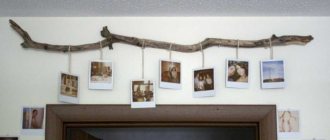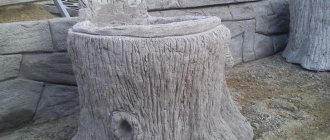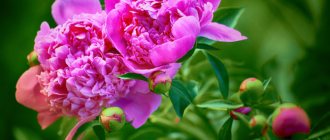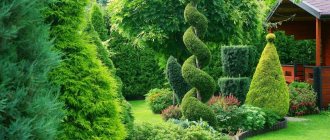In nature, there are over 40 varieties of linden, as well as about 100 hybrids. Most trees are large, deciduous, reaching 30-40 m in height. They have a powerful root system. The maximum age of the plant is 150 years. Less common are individuals that have reached 300 years of age or more.
The tree is common in the forests of Europe, North America, and East Asia. Among the numerous varieties of linden in Russia, the most common are small-leaved and heart-shaped linden, which are considered the most unpretentious and resilient individuals, withstanding frosts down to -45°C.
Photo gallery
Fastigiata
Linden variety Fastigiata is distinguished by a narrow crown in the shape of a pyramid. Tree with large dark green leaves. In autumn they fall off, first turning shades of yellow.
The flowers are larger than other species; the tree begins to bloom in June. The height can reach 20 m, the crown diameter is about 4 m.
The plant prefers fertile and moderately moist soils. Loves sunny areas, can only tolerate light partial shade. This variety is frost-resistant and can also withstand short droughts.
Linden has high disease resistance and a good response to fertilizers (the tree especially welcomes ash and liming). The crown shape is easily adjusted by trimming. Recommended for landscaping narrow streets and for planting along fences.
Japanese Linden (Tilia japonica)
The tree reaches up to 20 m in height. Its homeland is East Asia, where Japanese linden is widespread. Grows in subtropical coniferous and deciduous forests. It is distinguished by abundant flowering, which lasts about 14 days.
Flowering begins later than other linden species, in July–August. PHOTO
The fruits are single-seeded nuts that ripen in early autumn. The growing season lasts from April to September.
Japanese linden is an exotic plant. Cultivated since 1866. Planting is done by seeds. The sowing depth is 2-3.5 cm. It grows best on the south side of the site. Used for street landscaping.
This plant is one of the best honey plants. Japanese linden honey has a pronounced aroma of flowers and a pleasant sweetish taste. In a liquid state it is transparent, with a yellowish or greenish tint. After crystallization it turns yellow. Used to treat colds and as a heart tonic.
Tea with the addition of Japanese linden leaf is highly valued.
Fastigiata Favorite
Fastigiata Favorite is a large-leaved linden, decorative. The crown is smooth, vertical, decorated with straight red shoots. The growth rate is average, the height is at least 11 m. The leaves are large, shaped like a heart, the color is dark, green.
It is recommended to tie the plant up for the first time after planting. The soil should not be waterlogged and should be moderately drained.
It is better to plant linden in sunny areas, light partial shade is allowed. It tolerates frosts well and requires watering only in the first days after planting and in especially dry seasons.
The shape of the crown can be adjusted by cutting and pruning. A mulching layer (9-13 cm of peat or wood chips) is needed around the trunk.
Linden (Tilia platyphyllos)
Settles in the forests of Ukraine, the Caucasus, and Europe. In Russia it is used to create parks and alleys. It is highly resistant to air pollution. Durable. Lives up to 500 years, some trees live up to 1200 years. It has a wide pyramidal, spreading crown. The trunk is straight, powerful, up to 6 m in diameter. Trunk height is up to 35 m. The shoots are red-brown and fluffy. Young shoots are bare. The leaves are ovate or oval, up to 14 cm long, 9 cm wide. Dark green, fleecy above, light below, with hairs in the corners of the veins. On petioles 2-5 cm long.
The flowers are yellowish or cream, collected in inflorescences of 2-5. Flowering begins in the 20th year of the tree’s life, in July.
The fruit is a spherical, ribbed, small nut with a thick shell.
The tree is winter-hardy. It grows quite quickly. Demanding on soil. Prefers drained, fertile substrates. Tolerates drought well. Resistant to urban environments.
Large-leaved linden is propagated by seeds and cuttings.
The flowers of this plant are widely used as medicinal raw materials. Flowers are collected from days 1 to 4 of flowering. During this period they contain the maximum amount of active substances. Lime blossom is dried in well-ventilated areas or in the open air, the temperature should not exceed +40°C. After drying, the raw materials are crushed and stored in tightly closed packaging. Humidity during storage leads to the loss of the aroma of flowers and their medicinal properties.
It has several decorative forms, among which the most popular are pyramidal, grape-leaved, dissected-leaved, and golden.
Recipes for various diseases
SOLISH, COLD, TRACHEITIS, PULMONARY
Pour 1.5 tablespoons of linden flowers with 1 cup of boiling water, leave for 20 minutes, strain. Take 1-2 glasses at night. This infusion can also be used for rinsing. Pour 3 tablespoons of dried linden inflorescences with 1 cup of boiling water, heat in a boiling water bath for 15 minutes, stirring. Cool, strain, add boiled water to a full glass. Take hot, 1/2 cup 3 times a day. Brew 1 tablespoon of dried linden inflorescences with 1 cup of boiling water. Boil for 10 minutes, strain. It has a diaphoretic, antipyretic, expectorant and anti-inflammatory effect. Take 2-3 glasses hot at night. Take equal parts of linden flowers and raspberry fruits. Pour 2 tablespoons of the mixture with 1 cup of boiling water. Boil for 5 minutes. Drink hot. Take linden and black elderberry flowers in equal parts and mix. Pour 2 tablespoons of the mixture with 1 cup of boiling water and boil for 5 minutes, strain. Drink the entire broth hot at once. Take peppermint leaves, black elderberry flowers and linden flowers in equal parts and mix. Pour 1 tablespoon of this mixture into 2 cups of hot water and boil for 8-10 minutes, then strain. Drink the decoction hot. Take equal parts of linden blossom and peppermint leaves. Pour 1 tablespoon of the mixture with 1 cup of boiling water. Take 2-3 glasses a day hot.
BRONCHITIS
To prepare the infusion, pour 1 tablespoon of linden flowers into 1 glass of boiling water. Take 1/2 cup 2-3 times a day. Prepare a mixture of linden flowers, black elderberry and chamomile, taken in equal parts. Brew 1 tablespoon of the mixture in 1 cup of boiling water. Boil for 10 minutes. Leave for 15-20 minutes, strain. Take hot, 1-2 glasses 2-3 times a day.
BRONCHIAL ASTHMA
Take 400 g of linden honey and aloe leaves, 25 g of linden inflorescences, birch buds, pine buds. Mix all ingredients and add 2 glasses of water. Boil for 15 minutes from the moment of boiling over low heat. Remove from heat and let sit for at least 8 hours. Add 0.5 liters of cognac. Take 1 tablespoon 3 times a day 30 minutes before meals. Take 300 g of linden honey, 25 g of linden inflorescences; 0.5 cups of water and crushed aloe leaves. Cook over low heat for 2 hours. Take 1 tablespoon 3 times a day.
UROLITHIASIS DISEASE
Pour 2 tablespoons of linden blossom into 2 cups of hot water and boil for 10 minutes. Drink 2 glasses at night. Helps with pain in the urethra and sand in the urine.
LACK OF LACTATION
Brew 1 tablespoon of dry linden leaves or buds with 1 cup of boiling water. Leave, wrapped, for 30 minutes. Take 1 glass 3 times a day before meals.
OBESITY
Grind dried linden flowers in a coffee grinder into powder. Take 1 teaspoon of powder 3 times a day. There is a weight loss of up to 5-6 kg per month.
PULMONARY TUBERCULOSIS
In folk medicine, it is believed that charcoal from linden wood, crushed and mixed with goat's milk, is good for treating pulmonary tuberculosis. Take this mixture 1 teaspoon 3 times a day. Take 50 g of linden blossom, 1.2 kg of linden honey, 150 g of birch buds, 100 g of aloe leaves, 1 glass of olive oil, 2 glasses of water. Melt honey in a saucepan and add chopped aloe leaves. Boil the mixture well. Separately, brew linden blossom and birch buds in 2 glasses of water. Boil for 1-2 minutes. After the honey has cooled, squeeze the juice from the birch buds and linden blossoms and mix it with honey. Pour the mixture into bottles, add equal amounts of oil to each. Shake well before use. Take 3 times a day, 1 tablespoon.
PHARYNGITIS
Pour 1 tablespoon of linden flowers with 1 cup of boiling water. Boil over low heat for 5 minutes. Leave for 15-20 minutes, strain. Take 1/2 cup 2-3 times a day as an antipyretic, and gargle with the same infusion.
Peptic Ulcer of the Stomach and Duodenum
Take 40 g of linden flowers, 30 g of fennel fruit and chamomile flowers. Take the decoction 1/2-3/4 cup 2-3 times a day before meals. Take 20 g of linden blossom and fireweed leaves, 10 g of chamomile flowers and fennel fruits. Pour 2 teaspoons of the mixture with 1 cup of boiling water. Leave, covered, for 15-20 minutes, strain. Take 1 to 3 glasses throughout the day.
ANGINA
Brew 1 tablespoon of crushed flowers with 1 glass of boiling water, leave for 20 minutes, strain. You can add 1 teaspoon of soda to the finished infusion. Gargle with hot infusion 4 times a day. INSOMNIA, NERVOUS TENSION, STRESS Take a bath with linden blossom. Pour 100 g of linden flowers into 2 liters of cold water, let it brew for 5-10 minutes. Then put on fire, boil for 5 minutes, remove from heat and leave for another 10 minutes. Strain the broth and add to the bath. Take once a week for up to 20 minutes. The water temperature in the bath should not be higher than 37°C. Before taking a bath, wash your body with soap; after taking a bath, do not rinse.
HAEMORRHOIDS
Pour 3-4 tablespoons of linden leaves with 1 cup of boiling water, leave for 15-20 minutes without straining. Wrap the steamed raw material in gauze folded in 3-4 layers and apply it to the anal area before going to bed, covering it with plastic wrap. Keep the poultice for at least 1 hour.
HEADACHE
Apply fresh young linden leaves to your forehead.
LARYNGITIS
Pour 15 g of linden blossom with 1 cup of boiling water, leave for 20-30 minutes, strain. Use hot infusion for inhalation.
MASTITIS
Pour 3 tablespoons of dried linden inflorescences with 1 cup of boiling water, heat in a boiling water bath for 15 minutes, stirring. Cool, strain, add boiled water to a full glass. Apply lotions 3-4 times a day. Pour 3-4 tablespoons of linden flowers with 2 glasses of water and boil for 15 minutes. Then cool to body temperature, strain and add 1/2 teaspoon of baking soda to the broth. Use as compresses and for rinsing. For compresses, you can use fresh steamed linden buds.
UROLITHIASIS DISEASE
Steam with a broom of linden leaves. Pour boiling water over 4 tablespoons of linden leaves, wrap in gauze and apply a compress to the back - to the area where the buds are located.
GOUT, JOINT PAIN
Make lotions and compresses on the joints from multi-layer gauze moistened with linden blossom infusion. Boil linden leaves with boiling water, apply hot to the joints, cover with parchment or film, and wrap. Keep the compress for 1-2 hours. For gout and rheumatic inflammation, apply pads filled with a mixture of linden and chamomile flowers, taken in equal parts, to the sore spots. Lightly moisten the mixture of flowers with boiling water, then heat it strongly over the fire in a saucepan and, filling a bag with them (flowers), apply it to the sore spot.
COLD
Pour about 100 g of linden blossom into a large enamel pan, pour in 3-4 liters of boiling water and put on fire. As soon as it begins to boil, reduce the heat to low. Simmer over low heat with the lid tightly closed for 30 minutes. After this, remove the pan from the heat and cool the broth without opening the lid until it cools. Then squeeze out the herbal mass through a colander. Strain the solution through cheesecloth. The broth can be stored in a cool, dark place for no more than two days. Use to generate steam in a sauna (pour onto hot stones). After leaving the steam room, drink linden tea.
WOUNDS, ULCERS, BURNS
Take young fresh leaves or buds of linden, pour boiling water over them, wrap them in gauze folded 3-4 times and use them in the form of poultices and compresses.
STOMATITIS, GINGIVITIS
Pour 1 tablespoon of linden flowers with 1 glass of boiling water, leave for 20-30 minutes, strain. Rinse your mouth with hot infusion.
Tomentosa linden (Tilia tomentosa)
Grows in Ukraine, Western Europe, Asia Minor and the Balkans. Cultivated in Crimea, the Caucasus, and the Baltic states. Settles in the vicinity of maple, oak, and ash.
The tree reaches up to 30 m in height. It has a developed, wide-pyramidal, spreading, later oval crown of regular shape. The branches are clearly ascending. The trunk is slender, regular cylindrical in shape. The bark is dark gray, smooth. At a more mature age, it becomes fissured. The buds are round-oval. Young cuttings, leaves and shoots are densely pubescent. Over time, the pubescence disappears. The upper side of the leaves is dark green, the lower side is white, with fibers. The leaves have an oval shape, pointed at the apex. The length of the leaves is 6-8 cm. The edges are sharp, serrated, with a slight curve, which creates an effective contrast of dark green and silver shades. In autumn, the leaves turn yellow and remain on the tree until the end of autumn. Petioles are 2-4 cm long. The flowers are creamy and have a strong pleasant aroma. Collected in inflorescences - multi-flowered semi-umbrellas. Flowering begins in mid-July and lasts up to 10 days. The fruits are small, ovoid, short-pointed nuts 1 cm long.
Linden is light-loving, shade-tolerant, and grows very quickly. It is not demanding on soil fertility. Prefers dry, fertile, fresh soil. Drought resistant. Tolerates city gas pollution. In large cities, with the onset of the first frost, young trees should be covered, otherwise they begin to branch and grow in the form of a bush.
The tree has decorative value. Recommended for urban landscaping and gardening. Planted in parks and alleys. Particularly attractive during the flowering period. Looks beautiful in alley planting, in groups and alone. Lives up to 200 years.
Felt linden wood is soft, viscous, and densely fibered. It is easy to split and process, cut, saw, grind, quickly and dries out little. It has a yellowish-white tint. Used for making furniture, plywood, and carving. Charcoal and cellulose are obtained from it.
Planting is done mainly with seeds, which are pre-stratified.
Decorative types of felt linden: Brabant variety and Varsaviensis variety, used in landscape design.
Linden trees: classification of subspecies.
In order to choose the right linden tree for a harmonious combination with other plants and landscape objects, you need to familiarize yourself with the characteristics of each subspecies. The heart-shaped linden, a photo of which you can see on our website, will take root well with:
- European types of linden - felt or silver;
- large-leaved;
- ordinary.
All of them feel great in the conditions of the European part of Russia, have a pyramidal crown, small or large serrated heart-shaped leaves. The ease of forming the crown allows you to create an original design for a linden alley or other design composition.
The cordifolia linden, described above, has several varietal subspecies. Thus, the Greenspire variety is excellent for creating hedges and alley plantings. Compact Bohlje trees with a small, egg-shaped crown are ideal for landscaping areas of limited area. And Green Globe varietal plants have a unique spherical crown that does not require pruning, having the ability to maintain an initially neat shape.
Amur linden (Tilia amurensis)
Deciduous tree up to 30 m high. In nature, it grows in coniferous and deciduous forests in the Far East, Korea and China. Distributed to the north along the Bureya and Amur rivers. Often settles in river valleys and on mountain slopes.
The crown of the tree is oval and dense. The trunk is straight, reaching 1 m in diameter. The bark of young individuals is red-brown, smooth, slightly flaky. In old trees, the bark is dark gray, with deep grooves, and tends to peel off. The leaves are round, wide, heart-shaped, sharply toothed, 7 cm long. The edges are double-serrate. In spring they are light green, with bright red stipules, in summer they are dark green, in autumn they are light yellow. The flowers are pale, cream-colored, collected in inflorescences of 5–15 pieces. Flowering begins in late July - early August. The timing of flowering depends on the air temperature. So, in hot weather, flowering begins earlier. The fruits are spherical, elongated, smooth, ribbed, brown-yellow or grayish-brown nuts. Slightly pubescent. Ripen in September.
In its biological properties and appearance, the Amur linden resembles the small-leaved linden, but grows more slowly. Shade-tolerant. Frost-resistant. It has a powerful, highly developed root system. Wind resistant. Prefers moderately moist, fertile soils. Propagated by seeds, layering and stump shoots. The seeds are stratified immediately after collection and sown next spring to a depth of 3 cm. The lifespan of the tree is about 300 years.
The plant is an abundant honey plant. Has decorative value. Large leaves and numerous flowers in inflorescences make this tree very beautiful. Amur linden is used in park and single plantings.
The tree is a valuable tree species of commercial importance. It is under guard. Felling linden for industrial purposes is prohibited in the Amur Region, Perm and Khabarovsk Territories.
Rathaus
Rathaus is an ornamental variety of large-leaved linden. The tree has a dense dense crown, dark green leaves, embossed. Characterized by rapid growth, height - 14-20 m.
Young linden is columnar, but with age the crown becomes more spreading. It blooms in June and produces nut-shaped fruits. Young foliage is light green, more mature foliage is dark green. In autumn the leaves turn yellow and fall off.
Rathaus prefers fertile, well-drained soils and tolerates fertilizing well during active seasons (spring, summer, autumn). Bright sunny places are best suited for planting, but the tree also does well in light partial shade.
Reacts calmly to pruning and trimming. During particularly dry times, watering is necessary.
Siberian linden (Tilia siberica)
Widely distributed throughout Russia in the West Siberian region, Tomsk and Krasnoyarsk. Most often grows singly. Occasionally found in broad-leaved forests of Western Siberia, where it forms small islands on moist, soddy-podzolic soils with lime. Reaches up to 30 m in height. It has a compact crown raised high above the ground. The trunk is straight, with a diameter of 2 to 5 m. The bark of young individuals is brown, smooth, with small lentils. Older trees have dark, cracked bark. The branches are red-brown, dark, bare. The leaves are round, alternate, toothed, sometimes lobed, up to 5 cm long, up to 6 cm wide. Dark green above, glabrous, light below, hairy at the corners. The flowers are regular in shape, white or yellowish-white, and consist of 5 sepals and 5 petals. Stamens numerous, 5-6 mm long. The ovary is superior, spherical, covered with white hairs. Flowering begins in July - August and lasts 14-15 days. The fruit is an oblong, pear-shaped, smooth, tuberculate nut with 1-3 seeds. The tree begins to bear fruit at the age of 19. Fruiting occurs in September.
Siberian linden lives up to 1000 years. Light-loving, but tolerates shade. Demanding on soil. Prefers loamy, podzolic, chernozem soils. Does not tolerate swampy conditions. Winter-hardy. It grows slowly. It begins to bloom at the age of 12. Reproduces by seeds and vegetatively, produces stump shoots.
The wood of this plant is used to make furniture, plywood, and musical instruments. The bark of young trees is used to make bast for weaving baskets. Linden inflorescences are consumed orally as an infusion as a diaphoretic. Honey from Siberian linden is one of the best varieties and is of high quality. Siberian linden is very sensitive to weather changes, so a good honey harvest does not happen every year. The most favorable weather for abundant nectar release is hot weather with periodic thunderstorms. Wood is also used for decorative purposes.
Flower Festival
Flowering occurs in the summer months (late June – July). The flowers are small, in numerous corymbose inflorescences, each of which has a well-defined bract resembling a wing. It is leathery, colored in light green or yellowish tones, and turns brown in the fall.
Linden flowers, although small, are quite attractive. Their petals are colored yellowish-whitish, the stamens are numerous, well developed, surrounding the central pistil.
Lushly blooming linden trees seem to be covered with golden foam, behind which the leaves are sometimes indistinguishable. But the main advantage of linden blossom is its wonderful smell. During the flowering period, linden trees resemble buzzing beehives. The bees diligently collect a rich harvest of nectar, which will later turn into linden honey, fragrant in the hot summer.
Type Tokorish
The Tokorish type is a linden tree with small, dark green, heart-shaped leaves. The tree grows more than 10 m from the ground. The crown is formed by straight vertical shoots, located densely. It blooms in July and after flowering produces fruits in the form of nuts.
The Tokorish type is light-loving and does not like shadows. Frost-resistant and tolerates urban environments, but does not respond well to salty soils. During the growing season it requires fertilizing (liming, ash, nitrogen fertilizers). Formative pruning is best done in summer.











